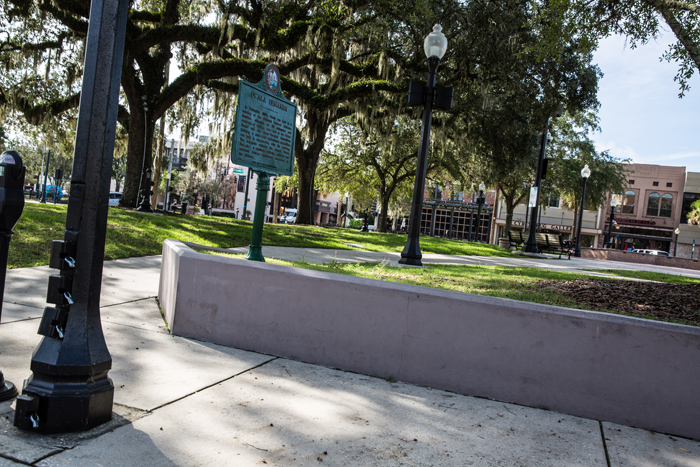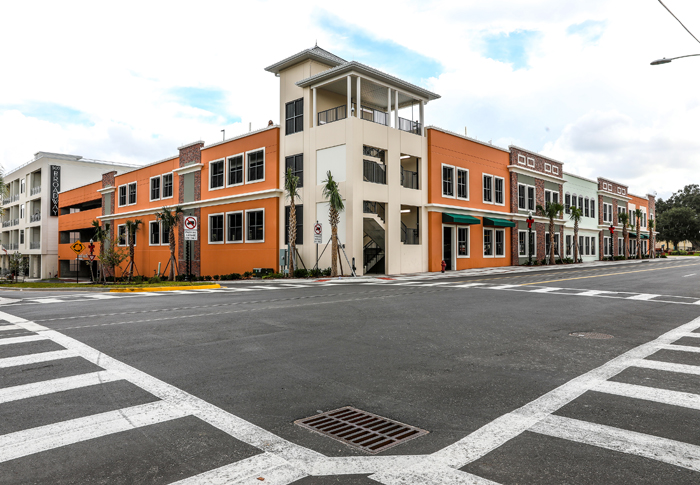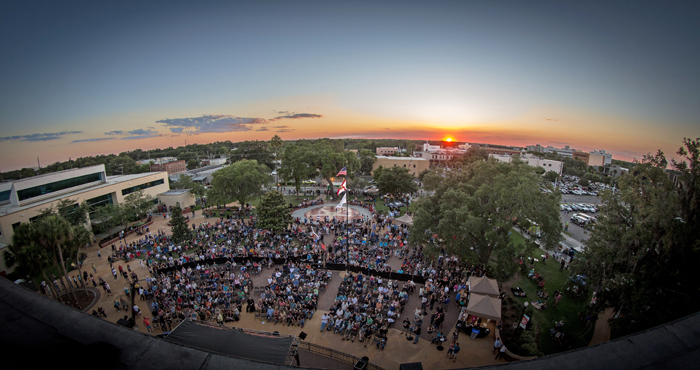
If you can tell what a person is made of by their response to tough times, the same could also be said of a city. New projects throughout Marion County signal growth as Ocala and Marion County turn the page on the recession.
When the American economy was body-slammed by a world-wide recession that began in 2008 and eventually wiped out 8 million jobs, Florida was one of the states hardest hit. Things were hardly bright in the Sunshine State, which ranked among the top five states in the nation for bankruptcies and foreclosures.
Things weren’t much better close to home, as Marion County’s unemployment rate was at 14.2 percent during the height of the recession.
What a difference a few years can make.
Making Strides
According to the U.S. Department of Labor, as of September 2016, unemployment in Ocala was down to 5.9 percent. Forbes Magazine ranks Ocala among the Top 10 Cities for Future Job Growth for the fourth year in a row. Forbes also ranks the cost of living in Ocala at 6.9 percent below the national average.
“It really is a credit to the community how well it’s bounded back from such a devastating low point just a few years ago,” notes Kevin Sheilley, president and CEO of Ocala/Marion County Chamber & Economic Partnership.
“If you look at retail, jobs and housing, there’s a lot of positive activity county-wide. Looking at the private, non-farm payroll numbers, we’ve added over 10,000 jobs in our local economy over the past three years,” he explains.
“We have expansion from existing businesses and new companies coming to the area. Downtown is doing well. The industrial center and State Road 200 are all doing well; those key areas are really very strong,” says Sheilley.
“When you look at retail space, you find there’s not much vacant space available in our community. Paddock Mall is 100 percent leased, which in this environment is incredible. Out in Heath Brook there are over a half dozen projects that were announced by the end of 2016,” he adds.
“Trying to buy a house in Ocala has become more difficult,” Sheilley notes. “The average house price is up about 40 percent in just the last 18 months. Inventory is down to about five months of homes on the market, so we’re at a seller’s market now, and we’re also starting to see lots of new home construction. In Ocala, we have several multi-family home projects already in the works.
“Before, we thought 2016 was going to be the ‘big year,’ and now we’re looking at what we’re seeing coming down the pike and think 2017 will be even bigger. The momentum continues to build toward more growth, more services and more opportunities.”

A Plethora Of Projects
Growth and recovery mean a variety of projects for our area, a number of which have already been completed.
Among those is the Ocala Downtown Market, which had its grand opening this past October 29. With the market’s former site on the downtown square slated for development, it was time to move to bigger and better digs. The market relocated to the corner of SE 3rd Street and SE 3rd Avenue, across from City Hall and Citizens’ Circle.
“When we were on the square, the market was set up in a vacant lot where vendors had tents,” says Lorna Forest CEP, director of the Ocala Downtown Market. “Our new facility is an open-air pavilion with permanent roof cover that has lighting and overhead fans.”
Market patrons also appreciate restrooms, water fountains and a nearby ATM. The Ocala Downtown Market takes place from 9am to 2pm every Saturday, rain or shine.
“Response to the new location has been overwhelmingly positive,” says Forest. “The vendors absolutely love it, and the customers love coming here to shop. There are also places to sit, so you can eat after you shop.”
The market features a diverse assortment of farmers, artisans, craftspeople and food trucks. If you’re wondering if your favorite vendors will be selling on a particular Saturday, just check the website ocaladowntownmarket.com.
Speaking of downtown, the new downtown parking garage makes working and shopping in the heart of Ocala easier than ever.
With covered spaces for 402 vehicles, the four-level garage, which is owned by the City of Ocala, was completed in late September. Covering approximately half a city block, the garage runs from the corner of Broadway and Osceola Avenue to the corner of Fort King Street and Osceola Avenue.
“Past studies showed that parking was an issue downtown, and with the new hotel project coming, we knew we needed a garage. This was seen as a catalyst for downtown development,” says Sean Lanier, city engineer and director of water resources.
Built by Finfrock Construction, Inc., the parking garage was designed to look like a building skyline, with its classy appearance and color block scheme.
“We’ll be putting in more meters for convenience parking in front of downtown stores, but the parking garage will remain free,” notes Lanier.
And parking hasn’t just improved downtown. At the Ocala International Airport, phase one of the terminal parking lot improvements was completed this past summer, with 150 spaces now available.
The airport may not be huge, but it’s definitely busy. In fact, it’s close to being one of the top 100 busiest contract tower airports in the country. (Contract tower means the facility is owned by the airport and air traffic control services are provided by a private company that is contracted by the FAA.)
Air traffic in and out of the Ocala International Airport is “general aviation,” which encompasses recreational, corporate, charter and military flights, basically everything but scheduled airline service.
“We’re seeing positive economic growth and strong recovery. Our fuel sales are increasing and the airport continues to be self-sufficient,” notes Matt Grow, director of Ocala International Airport.
Tax payers will be glad to know that the airport doesn’t require any of the City of Ocala’s general fund revenue. Airport users contribute to 100 percent of the facility’s financial stability.
“The airport opened in its current location in 1962. Before that, it was located off 200 near Target’s current site. Army Air Cadet training was done there in World War II,” says Grow. “The community was building up around the area in the 1950s, which is why the airport ended up getting relocated. One of the hangars was actually moved, so we have a hangar here built with 1930s-era steel.”
The last big airport project—the control tower—was commissioned in 2009 and became operational in 2010. Next on the agenda is a new terminal building.
“We’re actually in the pre-design process and have $2 million in grant funds now,” says Grow. “We have a $4 million budget for it currently but believe we need a $6 million budget, so we’re trying to come up with additional funding. We’re hoping for construction to begin around fall 2017.”
The new terminal will be approximately 18,000 square feet, which would more than triple the size of the current facility. This would ensure that all airport services—fixed base operations, rental car companies, administration offices, restaurant and meeting rooms—are conveniently housed in one building.
“It will truly be the front door to our community for aviators flying into Ocala,” says Grow. “We want to establish a good first impression of our area.”
As first impressions go, it doesn’t get much better than 302 Broadway. This eye-catching retrofit project is repurposing at its best since it took the old Sprint building, formerly owned by the city, and turned it into 18 stylish loft condominiums.
A residential project unlike anything else in the city, this unique offering features high-end contemporary living spaces with an industrial, upscale vibe you’d expect to find in a major metropolitan city. From the seamless polished concrete floors to the soaring ceilings, rustic vintage cypress accent walls and spacious balconies, the condos range in size from 828 square feet to 1,549 square feet. There are six different floor plans. Unit owners can also take advantage of the rooftop veranda with outdoor kitchen.
The building consists of three floors, and there are six condominiums on each floor. By the end of October 2016, eight of the units were sold and some were already occupied.
“The city is doing a lot for the urban center, and getting people to live downtown is a key component,” remarks Nathan Garcia, broker associate with McBride Land & Development Co., which owns the property and handled every phase of the project.
Whether you live downtown or just come to enjoy all there is to see, you don’t want to miss the Tuscawilla Art Park and the Osceola Trail.
The Tuscawilla Art Park saw its grand opening on October 15 in conjunction with the Tuscawilla Centennial Celebration. This almost three-acre parcel of land connects with the west side of Tuscawilla Park and is located east of Ocala Union Station with road frontage on NE 5th Street.
The public gardens, walkways, multiple plazas and canopied stage comprise a designed urban landscape that city officials believe will entice visitors and artists alike.
“It’s a wonderful place to reflect and a great place for picnics, celebrations and parties. It’s a space for the general public to host private and public events,” says Melissa Townsend, community cultural arts manager for the City of Ocala. “We’re hoping local artists will utilize the park for both the creation and display of visual and performance art.”
Park visitors may have already noticed the sculpture created by local artist Aspen Olmstead. Titled The Web We Weave, this repurposed/recycled art piece was created using plastic trash pieces collected at Tuscawilla Park over the years.
A wall and arch created by area artists is built from local fieldstone and features unique artistic components. Under a massive live oak, there’s a “Story Stone” designated for storytelling.
“In the future, we’ll be expanding the public garden beds and hope to have a community partner come forward to help us with a water feature. We have electric and water conduit in place to add this,” notes Townsend.
“The Ocala Rotary Club has selected the park for construction in 2019 of a beautiful arbor with seating in order to celebrate their centennial anniversary,” she adds.
You’ll soon be able to access the park via the Osceola Trail, a bicycle and pedestrian walkway just over a half-mile long.
“This concrete and brick ‘multimodal’ trail will allow people to walk or bike across downtown all the way from the Ocala Downtown Market to the Tuscawilla Art Park,” says Lanier. “It’s already designed and is a Florida Department of Transportation grant project. Construction will begin summer 2017, and we expect it to be ready for use within 90 days, so it should be done before Light Up Ocala.”
The trail will be built on the west side of Osceola Avenue and run from SE 3rd Street all the way to NE 5th Street.
“The Osceola Trail will be a way to facilitate connection,” says Lanier. “In the future, we look for it to include art work, scenic plantings and treescapes as the city obtains easements to enhance the trail,” Lanier notes.
No doubt visitor traffic to the heart of Ocala will increase once the downtown mixed-use hotel/retail/residential project is complete.
Destined for the corner of Silver Springs Boulevard and Osceola Avenue, right across from the downtown square, the former chamber lot will become the site of a 100-room hotel, retail shops and apartments.
“A hotel is usually part of revitalization and will bring new life to downtown. Success breeds success. Investors and developers are interested in coming downtown now,” says Bill Kauffman, assistant city manager. “We would like people to work, live and shop downtown; we want to make it a destination.”
Kauffman notes that the $16 million project, which is slated to begin construction in late 2017, will feature two separate buildings. The hotel, which will be built first, will likely be six floors and about 90,000 square feet, with about 10,000 square feet designated for restaurants and meeting rooms on the first floor.
The next phase of the project will include a second building, which will face Osceola Avenue and contain about 8,000 square feet of town homes/apartments and also feature a small retail area of approximately 1,800 square feet.
Business Expansion
If you’ve been downtown lately, you’ve probably noticed the major renovation and facelift of the old Alarion Bank building, now known as The One Center, which began leasing retail and office space in summer 2016.
But there’s much more happening in our city, some of which has been in the works for nearly a decade.
“We’ve been following through on plans that have been developed over the past 10 years,” notes Melanie Gaboardi, director of revitalization strategies for the City of Ocala.
Gaboardi explains that the city works in partnership with the Ocala/Marion County Chamber & Economic Partnership.
“They are our designated economic development office, and their role is to recruit and retain businesses and also function as the local chamber of commerce,” she says.
“We did a lot of ground work when we were in the recession and spent that time preparing for this kind of activity. Now that effort is coming to fruition because we did the work and have the properties for these kinds of projects to occur.”
A good deal of that activity is taking place in the Ocala Marion County Commerce Park, an almost 500-acre site located just east of I-75 and north of U.S. Highway 27. The new industrial site on NW 35th Avenue Road was a joint collaboration between the county, city and developer; the property is owned by Ocala 489, LLC.
Both the city and the county played major roles in building the roads around and into the area, providing the necessary infrastructure to attract shipping giant FedEx Ground, which came into the commerce park to build its new regional distribution hub on 150 acres and recently expanded to include an additional 30 acres.
“FedEx is up and running,” notes Gaboardi. “When we contracted with them, they committed to spend $122.9 million and provide 165 jobs. We know they have spent well in excess of that amount and increased to 500 jobs. When they requested applicants for those 500 available job openings, they received over 2,000 applications.”
The positions offered by FedEx put the company among the ranks of Marion County’s biggest private employers.
“Across the street from FedEx, AutoZone is building a 400,000-square-foot distribution center with an investment of at least $45 million, including the facility and equipment,” says Gaboardi. “They are in the process of acquiring land and, based on our contract, are committing to 192 jobs with an average annual salary of $38,003.”
Not all the new business activity is located downtown or in the industrial area, though.
Another newcomer to Ocala’s business scene will be Rural King, known as “America’s farm and home store,” which is planning to build on a vacant parcel at the corner of NW 27th Avenue and U.S. Highway 27.
The corner of West State Road 40 and SW 24th Avenue in West Ocala will soon become Paradise Park Plaza, a shopping center with Sav-A-Lot grocery as the anchor, along with a pharmacy, credit union and possibly one or more restaurant businesses. The police substation currently at this location will be relocated to another site on the same property.
“The city owns the property, which is 2.56 acres, and we have contracted with a local developer,” says Gaboardi. “This project is now viable and will include services the community hasn’t had easy access to. We anticipate the plaza being open by the end of 2017.”

Marion County By The Numbers
1,652 square miles (fourth largest county in Florida)
344,100: county population
56,315: Ocala population
4,492: Belleview population
1,733: Dunnellon population
506: Reddick population
452: McIntosh population
$41,783: median household income
$122,700: median home price
Sources: 2012 U.S. Census Bureau, Forbes Magazine






